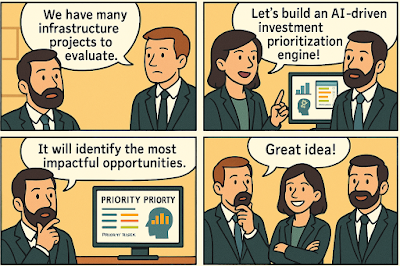How to Build AI-Driven Infrastructure Investment Prioritization Engines
Governments, municipalities, and infrastructure funds often face the same challenge: too many projects, not enough budget.
Deciding which road to widen, which bridge to replace, or which renewable energy facility to fund is a complex balancing act between economic impact, ESG performance, and risk exposure.
AI-driven prioritization engines offer a solution—combining data from multiple domains to score and rank infrastructure proposals dynamically.
This article explains how to design and deploy these engines to support smart, transparent capital planning.
Table of Contents
- Why AI Is Needed for Infrastructure Prioritization
- Data Inputs and Policy Alignment
- AI Models and Ranking Algorithms
- Platform Architecture & Output Formats
- Recommended Tools and Examples
🏗️ Why AI Is Needed for Infrastructure Prioritization
Traditional cost-benefit analysis lacks the ability to handle:
- Multi-stakeholder preferences (governments, residents, investors)
- Dynamic environmental and social risk data
- Scalability across hundreds of proposals
AI systems streamline this by analyzing structured and unstructured data in real time and delivering auditable, ranked shortlists.
📊 Data Inputs and Policy Alignment
- Project CAPEX, ROI forecasts, and O&M costs
- Climate risk maps (flood zones, wildfire forecasts)
- Equity impact assessments (benefit to underserved areas)
- Public feedback, council transcripts, and social listening
- Alignment with SDGs, local climate plans, or federal mandates
🧠 AI Models and Ranking Algorithms
- Multi-objective optimization (Pareto ranking, AHP)
- ML classifiers trained on past investment decisions
- Natural Language Processing (NLP) on environmental impact studies
- Reinforcement learning for dynamic prioritization feedback loops
All models should include transparency layers for government reporting.
🧰 Platform Architecture & Output Formats
- Modular input interface with project templates
- Scoring engine with weighted criteria sliders
- Export options: PDF reports, dashboard embeds, CSV for audit trail
- Role-based access (urban planner, budget analyst, ESG officer)
🔎 Recommended Tools and Examples
- OpenDataSoft: Public data integration engine
- Tableau + Power BI: Investment portfolio visualization
- Gurobi: Optimizer for infrastructure allocation
- Civis Analytics: Decision intelligence for civic planning
🔗 Related Urban Planning & AI Posts
Keywords: AI infrastructure prioritization, capital planning engines, ESG investment ranking, public sector AI tools, smart city planning AI

